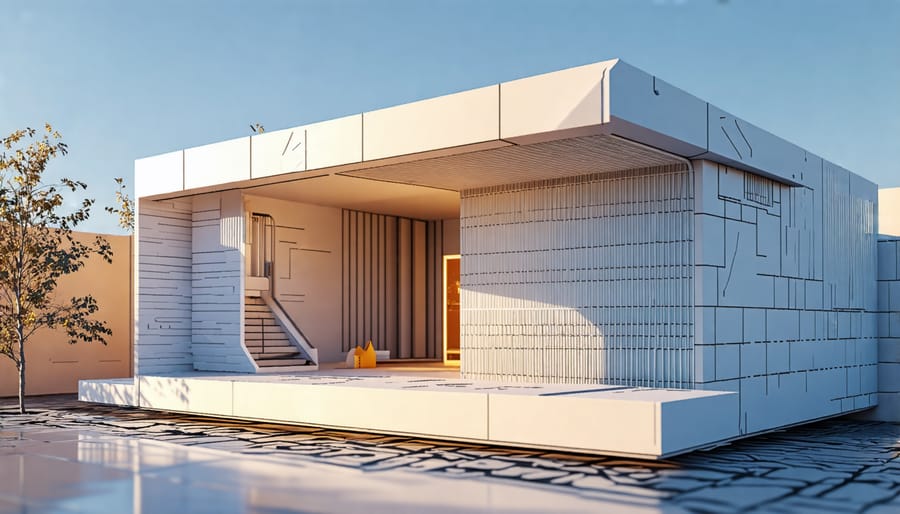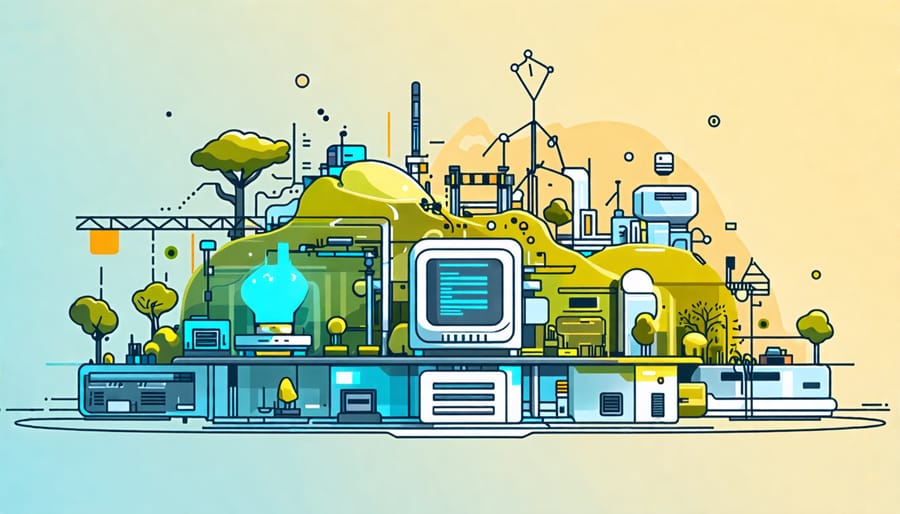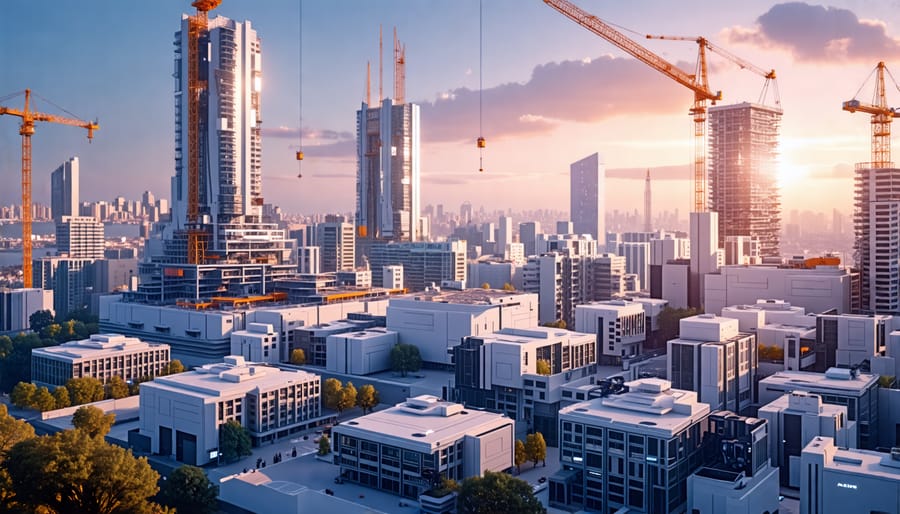The future of 3D printing in construction holds exciting potential to revolutionize the industry over the next decade. From rapid prototyping and customized components to entire buildings constructed with large-scale 3D printers, this transformative technology promises to reshape how we design and build. As materials advance and costs decrease, 3D printing stands poised to dramatically improve efficiency, sustainability, and design possibilities – ushering in a new era of innovation for the construction sector. Preparing now to harness its power will position forward-thinking firms for success in the years ahead as 3D printing moves from niche applications to a mainstream construction tool. The question is not if, but when and how this game-changing technology will redefine the future of building.
Current State of 3D Printing in Construction

Materials and Techniques
The construction industry is witnessing a surge in the adoption of 3D printing technologies, with a variety of materials and techniques being explored for their potential applications. Concrete is one of the most widely used materials in 3D printed construction, with companies like ICON and WinSun pioneering large-scale printing of concrete structures. These firms employ specialized extrusion systems that deposit layers of high-strength, quick-setting concrete to create walls, floors, and roofs. Another promising material is geopolymer, a more environmentally friendly alternative to traditional concrete that offers excellent durability and fire resistance.
In addition to concrete-based materials, metal 3D printing is gaining traction in the construction sector. Techniques like Wire Arc Additive Manufacturing (WAAM) and Selective Laser Melting (SLM) enable the creation of complex, lightweight structural components with improved strength-to-weight ratios. These methods are particularly well-suited for producing customized, load-bearing elements such as joints, trusses, and facades.
The use of composite materials, such as fiber-reinforced polymers, is also being explored for 3D printed construction. These materials offer high strength, low weight, and excellent corrosion resistance, making them ideal for applications like bridges, façades, and temporary structures. Companies like Branch Technology are pushing the boundaries of composite 3D printing, creating intricate lattice structures that optimize material usage and structural performance.
As the technology advances, multi-material 3D printing is emerging as a promising approach for creating more functional and efficient buildings. By combining different materials with varying properties, such as insulating foams, conductive materials, and reinforcing fibers, architects and engineers can design structures with integrated mechanical, electrical, and thermal systems. This holistic approach to 3D printed construction has the potential to revolutionize the way buildings are designed, built, and operated in the coming years.
Pioneering Projects
Several groundbreaking projects showcase the potential of 3D printing in construction. For example, in Dubai, the world’s largest 3D-printed building, a two-story administrative office spanning 6,900 square feet, was constructed using a single 3D printer in just 17 days. Meanwhile, in the Netherlands, a 3D-printed concrete bridge for cyclists was completed in 2017, demonstrating the technology’s ability to create complex, functional structures. In Mexico, a 3D-printed neighborhood is underway, aiming to provide affordable, sustainable housing for low-income families. These pioneering projects not only push the boundaries of what’s possible with 3D printing but also highlight the technology’s potential to revolutionize construction processes, reduce costs, and address pressing global challenges such as housing shortages and environmental sustainability. As more innovative projects emerge, the construction industry will continue to explore and harness the transformative power of 3D printing.
Benefits and Challenges
Cost and Time Savings
3D printing offers significant potential for cost and time savings in the construction industry. By streamlining the fabrication process, reducing material waste, and minimizing labor requirements, 3D printing can help cut construction costs by up to 60%. Additionally, this technology enables faster project completion, with some estimates suggesting a reduction in construction time by 50-70%. The ability to print complex structures in a single piece eliminates the need for multiple assembly steps, further expediting the process. Moreover, 3D printing allows for on-site fabrication, reducing transportation costs and logistical challenges. As the technology advances and becomes more widely adopted, it is expected to drive down costs and improve efficiency even further, making it an attractive option for budget-conscious projects and tight timelines. These cost and time savings will be crucial in addressing the growing demand for affordable housing and infrastructure development in the coming years.
Design Freedom
The advent of 3D printing in construction offers unprecedented opportunities for architects and designers to push the boundaries of what’s possible. With this technology, the limitations of traditional building methods are becoming a thing of the past. 3D printing enables greater design flexibility, allowing for complex geometries, intricate details, and customized elements that were once impractical or cost-prohibitive. Designers can now create structures with unique shapes, curves, and lattices, optimizing both form and function. Moreover, 3D printing facilitates mass customization, enabling the production of bespoke components and tailored designs for individual projects without the need for expensive retooling. As 3D printing continues to evolve, it will empower architects to bring their most innovative visions to life, redefining the aesthetics and functionality of the built environment.

Technological and Regulatory Hurdles
Despite the promising potential of 3D printing in construction, several technological and regulatory hurdles currently hinder its widespread adoption. One significant limitation is the size of 3D printers, which restricts the scale of printable structures. Developing larger, more robust printers capable of creating full-scale buildings remains a challenge. Additionally, the range of printable materials is still limited, with most printers relying on concrete-based mixtures. Expanding the material palette to include more sustainable and versatile options is crucial for broader application.
Regulatory challenges also pose barriers to 3D printing in construction. Building codes and standards have not yet caught up with this emerging technology, leading to uncertainty regarding the safety and compliance of 3D-printed structures. Establishing clear guidelines and testing protocols is essential to ensure that printed buildings meet the same structural and safety requirements as conventionally constructed ones. Furthermore, the lack of standardized training and certification programs for 3D printing operators in construction hinders the availability of skilled workforce needed to scale up the technology’s adoption.
Overcoming these technological and regulatory hurdles will require collaboration between industry stakeholders, researchers, and policymakers. Continued investment in R&D efforts to improve printer capabilities, material options, and automation will be key to pushing the boundaries of what is possible with 3D printing in construction. Simultaneously, proactive engagement with regulatory bodies to develop appropriate standards and guidelines will create a supportive framework for the technology’s integration into mainstream construction practices.
Future Developments
Material Innovations
As 3D printing technology evolves, so do the materials used in construction applications. Researchers and companies are developing innovative materials that could significantly expand the capabilities and applications of 3D printing in the built environment. For example, nanoengineered concrete with superior strength and durability is being explored for 3D printing, allowing for more complex and resilient structures. Additionally, the use of recycled materials, such as plastic waste and demolition debris, is being investigated as a sustainable feedstock for 3D printing, reducing the environmental impact of construction projects. Bio-based materials, including mycelium (fungal roots) and cellulose, are also showing promise as renewable and biodegradable alternatives for 3D-printed building components. As these emerging technologies mature, they could enable the creation of more sustainable, customizable, and high-performance structures, revolutionizing the way we build in the coming decade. However, further research and development are needed to optimize these materials for widespread adoption in the construction industry, ensuring they meet the necessary performance, safety, and regulatory standards. As the palette of printable materials expands, architects and engineers will have greater freedom to push the boundaries of design and functionality in the built environment.
Automation and Scale
The future of 3D printing in construction holds immense potential for automation and large-scale projects. As the technology advances, we can expect to see more robotic systems capable of autonomously printing entire structures with minimal human intervention. This could significantly reduce labor costs and improve efficiency on construction sites. Additionally, the scalability of 3D printing technology will enable the creation of larger and more complex structures in shorter timeframes.
Imagine a fleet of specialized construction robots working together to print a multi-story building, each focusing on specific tasks such as laying foundations, erecting walls, and installing utilities. These robots could operate 24/7, adapting to changing conditions and optimizing their performance based on real-time data. This level of automation would not only accelerate project completion but also enhance precision and reduce waste.
Moreover, the integration of artificial intelligence and machine learning algorithms could further optimize the construction process. AI-powered systems could analyze design data, material properties, and environmental factors to make intelligent decisions and adjustments on the fly. This would result in more efficient resource allocation, improved structural integrity, and better overall project outcomes.
As 3D printing technology continues to evolve, we can anticipate the emergence of large-scale construction projects that were previously considered impossible or impractical. From towering skyscrapers to sprawling residential complexes, the future of construction will be shaped by the power of automation and the ability to scale 3D printing to unprecedented levels.

Sustainable Construction
3D printing offers significant potential to revolutionize the construction industry with more sustainable and eco-friendly construction practices. By leveraging additive manufacturing techniques, construction firms can reduce material waste, minimize transportation emissions, and optimize resource efficiency. 3D printing enables the use of recycled materials and locally sourced raw ingredients, further reducing the environmental footprint of building projects. Additionally, the precision and customization capabilities of 3D printing allow for the creation of energy-efficient designs, such as optimized insulation and passive solar features, contributing to the long-term sustainability of the built environment. As the technology advances, 3D printing is poised to become a key driver of green construction practices in the coming years.
Conclusion
In conclusion, the future of 3D printing in construction is undeniably bright. As this revolutionary technology continues to advance and become more accessible, it has the potential to transform the industry over the next decade. The benefits of 3D printing, such as increased efficiency, reduced waste, and enhanced design flexibility, will drive its adoption and position it as a game-changer in the construction sector.
However, challenges such as regulatory hurdles, material limitations, and the need for skilled personnel must be addressed to fully realize the potential of 3D printing. As the technology matures and more successful projects demonstrate its viability, the construction industry will likely embrace 3D printing on a larger scale.
The next ten years will be crucial for the growth and widespread implementation of 3D printing in construction. With continued research, development, and collaboration among stakeholders, 3D printing has the potential to revolutionize the way we design and build structures. Construction professionals who stay informed, adapt, and leverage this technology will be well-positioned to lead the industry into a more efficient, sustainable, and innovative future.

